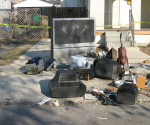6 Risks to Airport Ground Staff
Working in such a high-intensity environment, airport ground staff are subject to stringent health and safety protocols and undergo extreme assessments to show their awareness abilities. This is to ensure that they are well-prepared in the event of any possible dangers. But exactly how much risk do staff members face when working below the aircrafts? Is there more to be done to assure their safety?
Read on to see the risks that pose towards airport ground staff during an everyday shift. If you think your staff could do with some reassurance in the form of safety implements, then you can find the answers to your queries here.
May I Take Your Bags?
One of the most common duties of airport ground staff is to check the baggage before it boards the plane. This includes making sure baggage is stored in a tidy and efficient manner to reduce the chances of baggage damage and misplacement. Although this sounds somewhat simplistic, there is a constant risk of muscular damage.
Should a member of staff be careless when lifting and transporting any luggage, it can quickly lead to pulled muscles, back pain and joint issues; especially in the arms and legs. To reduce the risk of muscular and joint issues, all airport staff should be coherent with the correct lifting procedures at all times. Work based rick assessments should be carried out at regular intervals to ensure all staff members are doing their jobs properly and in the safest of methods. This is true even for airport office environments, where spending prolonged amounts of time sat at a desk can have adverse health effects.
Fuel Her Up!
On an average day in an airport, thousands of gallons of fuel are transported to aircrafts before and after take-off. So it comes as no surprise that fuel trucks are always present on the runways and terminal gates. During busy periods, it is extremely easy for damage to occur to the fuel truck, the driver, the plane, any buildings and even other staff in the event of a collision.
This can be dramatically reduced with the installation of flex impact airport safety barriers. Their modular design means they can be easily configured and transported to other locations on-site. What their presence does is alert the driver of the fuel truck that they are approaching an area of potential danger and therefore their awareness should be at a premium.
The shock-absorbent material means the barrier is extremely impact resistant. That means that in the event of a collision, the energy generated from the accident is dissipated amongst the body of the barrier and not back towards the source of the collision. This improves the safety of those involved with the accident, reducing staff injuries and vehicular damage too. It is also handy to know that the barriers are anti-corrosive and rust-proof!
All Aboard! For 600 Yards!
Although passenger buses are extremely handy, especially in typically miserable British weather, we do tend to look upon them with a sense of humour. In no other scenario would you hop on a bus for a limited amount of time, yet in an airport it guarantees our safety in the event we need to travel from the terminal gate to a distant plane for take-off. This is in the event that a plane is unable to properly board within the hangar to allow passengers on and off.
The idea that we can literally travel across a runway is absurd, so the nerves can be pretty high at the best of the times. The last thing you need is for a passenger bus to cause any damage to the passengers, driver, the vehicle itself or surrounding areas.
The implementation of a flex impact airport safety barrier can again protect the most important assets, passengers included. Bus drivers within the airport can use the barriers as a guide, whilst at the same time increasing their awareness in certain areas of the airport. Normally, barriers should be placed in front of buildings, vehicle storage areas and hangars. So, in the unfortunate event of a passenger bus losing control – which can happen in wet, slippery or icy weather – there is a safety measure installed to minimise the damage.
Other 4 Wheeled Protection
Considering the vast variety of vehicles that can be present in the airport on a daily basis, you expect that these vehicles are taken care of to the best of the airport’s ability. This includes more than just the shuttle bus!
With that being the case, there needs to be an adequate level of safety to help prevent catastrophic damage. A flex impact airport safety barrier helps to reassure those involved. Their vibrant presence can assist in designating a strong holding area for the vehicles, meaning important fleet vehicles such as baggage handlers and passenger buses can be kept safe throughout the year.
This is especially important in dangerous weather conditions, such as fog and heavy rain. Any weather which reduces the visibility of a vehicle can be dangerous. However, airport safety barriers are visible in just about any weather condition you can throw at them, meaning they can always be seen. This acts as a guide on how careful a vehicle driver needs to be, although this should be normal when operating in difficult conditions.
Blame it on the Weather
When working in such a high-intensity atmosphere and enduring the variety of weather conditions that Britain can bestow upon the airport staff, taking care of their own health is just as important.
It is extremely easy for staff to pick up the occasional colds and coughs, which can develop to issues such as the flu and chest infections, as just two examples. The more time you spend in extreme conditions the less of a fight their immune system is going to give.
To combat this, it is important that regular, achievable shift patterns are put into place to ensure every worker isn’t exposed to the extreme conditions for too long. It is also important to ensure the staff are wearing the correct clothing. Thermals are especially handy in winter etc.
As much as airport workers are at risk of colds and coughs, heat exhaustion is an equal risk when working in hot temperatures. Regular intake of water helps with minimising the risk of dehydration and loose, cotton clothing is ideal during the warmer temperatures too.
Pedestrians on the Ground
Visibility in airports is one of the most important safety measures you could think of. Even on the clearest of days it is vital every member of staff on the ground can be seen. However, this is especially important when the weather gets a little adventurous, leading to visibility impairments and the risk of not being seen clearly. This can lead to accidents that can quite easily be avoided with the implement of the correct safety clothing.
It is crucial that any workers operating within any area of the airport follow standard Health and Safety protocol by wearing bright high-viz clothing, making them visible to anybody that needs to see them.
A Strong Base Means Success!
Flex impact airport safety barriers can provide a variety of benefits. The robust base plates that are manufactured below the barrier itself can potentially save a lot of money. This is because of the fact that when a collision occurs against the barrier, as mentioned before, the energy generated is dispersed amongst the barrier’s body.
Because of this, the base plates remain rooted to the ground, rather than displacing themselves out of the ground, causing further damage and the possibility of floor repairs. This can cause significant delays in the airport’s operations due to the maintenance required to repair the issues.
However, with a barrier that can withstand the damage and keep its shape, appearance and colour; you’re guaranteed an airport safety barrier that doesn’t require frequent repairs. This means that the barrier can continue to protect everybody involved within the workforce, 365 days a year.
Get in Touch, Protect Today!
If you are interested in upgrading your airport’s safety level, whilst protecting your workforce and those involved in the day-to-day running of your airport, then you can get in touch with one of the Boplan team at 01902 824 280. The team there are more than happy to answer any questions you may have about their extensive range of airport safety barriers.
Regardless of the profession, or the environment, worker safety must be paramount if a workforce is to feel safe when coming to and going home from work. The inclusion of stringent, specific Health and Safety policies go a long way to ensuring complete safety. But then it is down to the awareness, diligence and care of the workforce to follow these guidelines.
That’s why it is important to identify a potential risk and resolve it effectively and efficiently. That way, the business and the workforce are compliant with company and government guidelines to safety, minimising the risk of several potential accidents.
Author: Zoe Price















